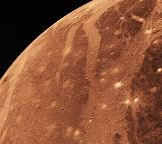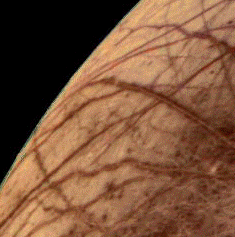 Callisto (1.9 Million km from Jupiter)
Callisto (1.9 Million km from Jupiter)
Very low density. Callisto seems to have little internal structure; however
there are signs from recent Galileo data that the interior materials
have settled partially, with the percentage of rock increasing
toward the center. Callisto is about 40% ice and 60% rock/iron.
Callisto's surface is covered entirely with craters. The surface is
very old, like the highlands of the Moon and Mars. Callisto
has the oldest, most cratered surface of any body yet observed
in the solar system; having undergone little change other than
the occasional impact for 4 billion years.
Callisto has a very tenuous atmosphere composed of carbon dioxide and shows no evidence of a magnetic field.
 Ganymede (1.1 Million km from Jupiter)
Ganymede (1.1 Million km from Jupiter)
Largest of Jupiter's moons and the largest satellite in the solar system.
It is larger in diameter than Mercury but only about half its mass.
Ganymede is much larger than Pluto. Ganymede is differentiated into
a three layer structure: a small molten iron or iron/sulfur core
surrounded by a rocky silicate mantle with a icy shell on top.
Ganymede's surface is a roughly equal mix of
two types of terrain: very old, highly cratered
dark regions (left), and somewhat younger (but
still ancient) lighter regions marked with an
extensive array of grooves and ridges (right).
Their origin is clearly of a tectonic nature, but the
details are unknown. Extensive cratering is seen on both types
of terrain. The density of cratering indicates an age of
3 to 3.5 billion years, similar to the Moon.
Ganymede has its own magnetic field embedded inside Jupiter's huge one, suggesting conducting material in Ganymede's interior. Ganymede may have a very tenuous oxygen atmosphere, but this is not a sign of life.
 Europa (0.7 Million km from Jupiter)
Europa (0.7 Million km from Jupiter)
Slightly smaller than Earth's Moon. Europa is primarily
composed of silicate rock with a thin outer layer of ice. Recent
data from Galileo indicate that Europa has a
layered internal structure perhaps with a small metallic core.
Europa's surface is exceedingly smooth, with few craters,
indicating a very young and active surface.
The images of Europa's surface strongly resemble images of
sea ice on Earth. It is possible that beneath Europa's surface
ice there is a layer of liquid water, perhaps as much as 50 km
deep, kept liquid by tidally generated heat. If so, it would be
the only place in the solar system besides Earth where liquid
water exists in significant quantities. Europa's most striking
aspect is a series of dark streaks criss-crossing the entire globe.
They are produced by a series of volcanic eruptions or geysers.